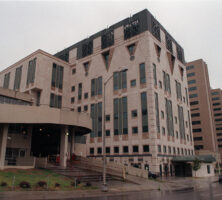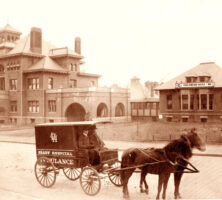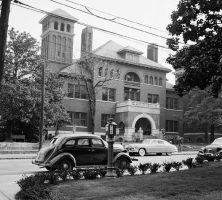Grady Health System is the largest public hospital–based health system in the Southeast, providing more than 200 specialty and subspecialty health care clinics. Included are Grady Memorial Hospital; Children’s Healthcare of Atlanta at Hughes Spalding, an affiliate of Children’s Healthcare of Atlanta; Crestview Health and Rehabilitation Center; nine neighborhood health centers; and the only level-one trauma center within a 100-mile radius of downtown Atlanta.
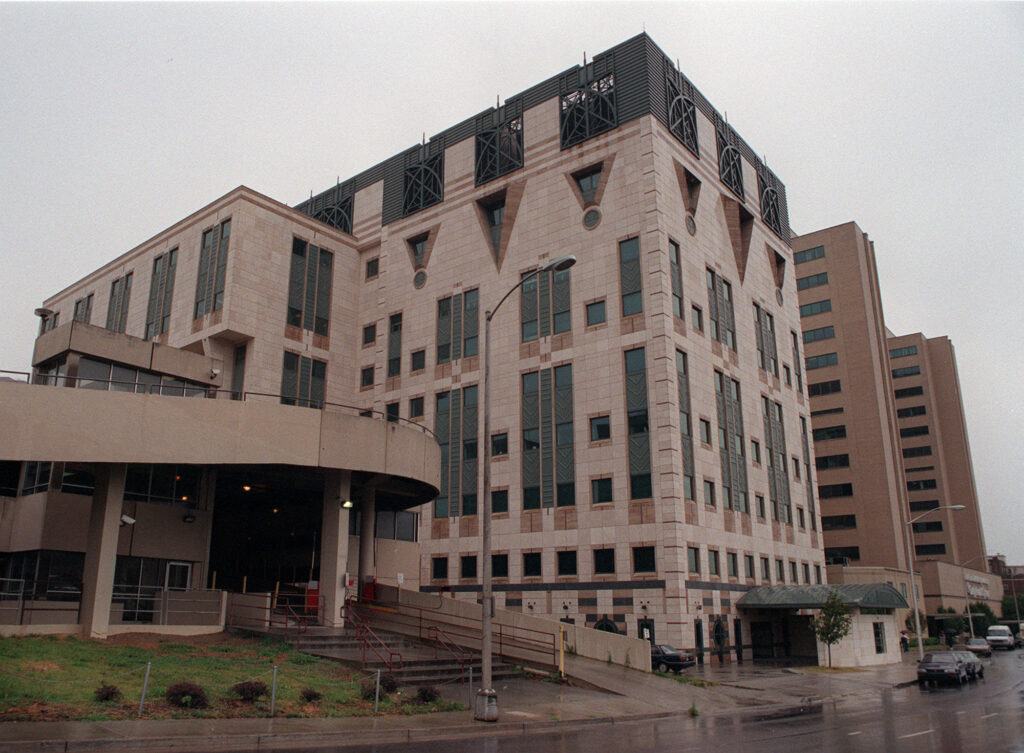
Courtesy of Atlanta Journal-Constitution.
The nucleus of Grady’s service area is Fulton and DeKalb counties in Atlanta, where Grady contracts to provide care for the medically underserved. Grady Memorial Hospital houses 953 licensed beds and 17 operating rooms, and the 5,000 employees of Grady Health System treated 921,000 patients in 2008.
Specialized Programs and Centers of Excellence
Grady has a nationally acclaimed burn unit and diabetes center, an obstetrical intensive care unit that is widely recognized for low mortality in a very high-risk patient population, a twenty-four-hour comprehensive sickle-cell center, and the Georgia Cancer Center for Excellence. The state’s poison center is at Grady, and Grady Emergency Medical Service, the ambulance 911 provider for the city of Atlanta, made more than 500,000 ambulance trips in 2004.
The largest publicly funded infectious disease program in the eastern United States is housed at Grady, with 41,876 outpatient visits in 2002. The National Association of Public Hospitals has three times recognized Grady in its First Place Safety Net Award Category: for the Grady Health System Breast Health Initiative Program, for the Grady Health System Diabetes Detection and Treatment Program, and for the innovative use of a hand-held computer technology in diabetes assessment.
Grady is an internationally recognized teaching hospital, staffed largely by physicians from Emory University School of Medicine and Morehouse School of Medicine. Twenty-five percent of all physicians practicing in Georgia received some or all of their training at Grady.
The Early Years
Grady Hospital is named for Henry W. Grady, managing editor of the Atlanta Constitution in the 1880s. After Reconstruction, Grady envisioned and actively promoted a “New South,” a vision that included not only industrial development but also a commitment to white supremacy. A year after his early death from pneumonia in 1889, the city council passed a resolution to build a hospital in his honor. The hospital was intended to provide health care for low-income families in Atlanta.
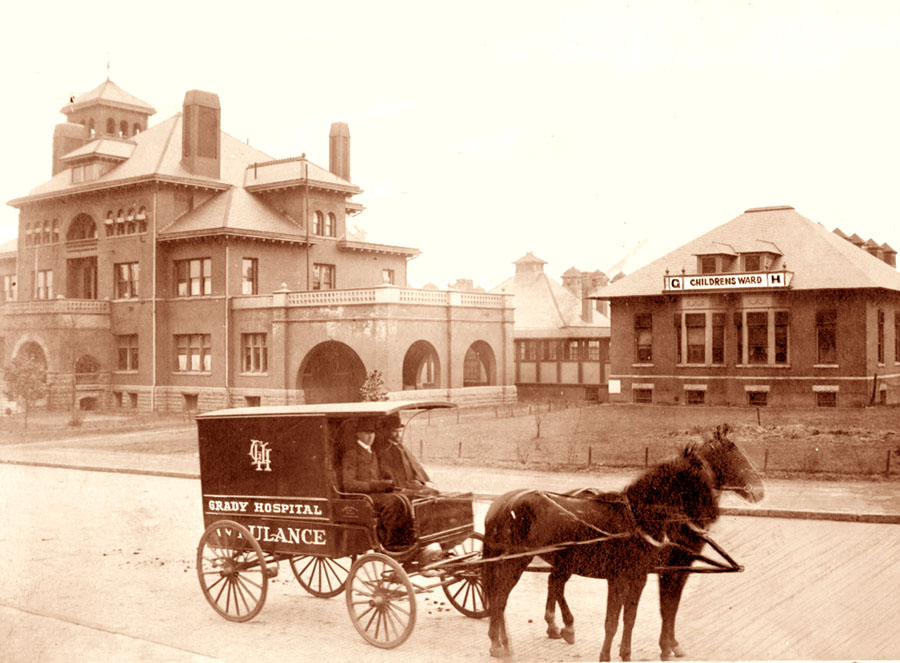
Courtesy of Special Collections & Archives, Georgia State University Library.
Grady Hospital opened on June 1, 1892, with 18 employees and 100 beds, roughly 50 each for Blacks and whites. The hospital featured one operating room with an amphitheater for students and staff. In 1899 the daily cost for a patient was $1.09. New construction completed shortly before World War I (1917-18) created separate white and Black hospitals, clinics, nurses’ quarters, and emergency rooms. Because of those separate facilities, the hospital was often referred to as “the Gradies,” a name that would stick until desegregation almost fifty years later.
The hospital was initially owned and operated by the city of Atlanta. In 1941 the Georgia General Assembly approved the concept of the Fulton-DeKalb Hospital Authority, a separate government entity composed of appointed board members who are jointly responsible for the health system’s operations. In 1954 construction began on a new building, which consisted of 21 floors with 1,100 beds and 17 operating rooms.
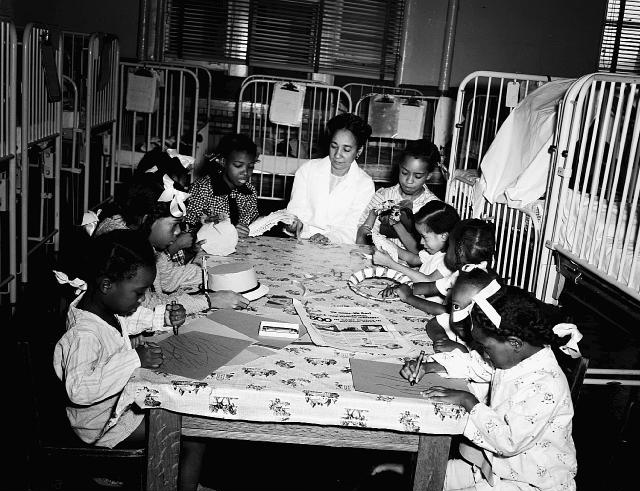
Courtesy of Special Collections & Archives, Georgia State University Library.
During the 1940s Margaret Mitchell, the author of Gone With the Wind, worked with Benjamin Mays, president of Morehouse College, to provide anonymous scholarships for Black medical students from Atlanta. Dr. Otis Smith, one of Atlanta’s first Black pediatricians, was aided by her generosity. In 1949 Mitchell was struck by a taxi and taken to Grady, where she died of her injuries.
Grady’s Role in Medical Education
Grady’s founders chose to locate the hospital near Atlanta Medical College (chartered in 1854), which supervised patient care. In May 1915 the Atlanta Medical College was acquired by Emory University; the Emory School of Medicine was initially housed not on the Emory campus but in a building across the street from Grady. In the 1940s it received national recognition when Dr. Eugene Stead helped bring a cardiac catheterization lab to Grady, one of only three labs in the world with such a facility at that time.
In 1975 a medical school was established at Morehouse College to assume up to half of the responsibility for patient care, medical education, and clinical research at Grady. The goal was to address the shortage of physicians among minority communities. The Morehouse School of Medicine remains committed to training doctors who will work in underserved communities and research diseases that disproportionately affect minorities and the poor.
For many years Grady also supported a nursing education program. Grady Hospital Training School for Nurses opened in March 1898, and in 1917 the Municipal Training School for Colored Nurses opened for African American nurses. The two schools merged in 1964. Because of rising tuition and a growing emphasis on the bachelor of science degree, the nursing school officially closed in 1982.
Medical Innovations
In 1921 a Grady physician performed the first open-heart surgery in Georgia. In 1923 the world’s first and largest comprehensive cancer center, the Steiner Clinic, was established. It lasted for about twenty-five years and was a model for future cancer centers throughout the country. Grady had the only polio center in Georgia, and it was a Grady physician, James Edgar Paullin, who attended U.S. president Franklin D. Roosevelt when he died in Warm Springs. Paullin was also the first to prescribe insulin to a patient in Georgia. Grady was one of the earliest hospitals to have a dialysis machine. Other early innovations adopted by Grady included the X-ray machine, diet therapy followed by studies in nutrition research, safe blood transfusions, sulfa drugs, and the establishment of a blood bank.
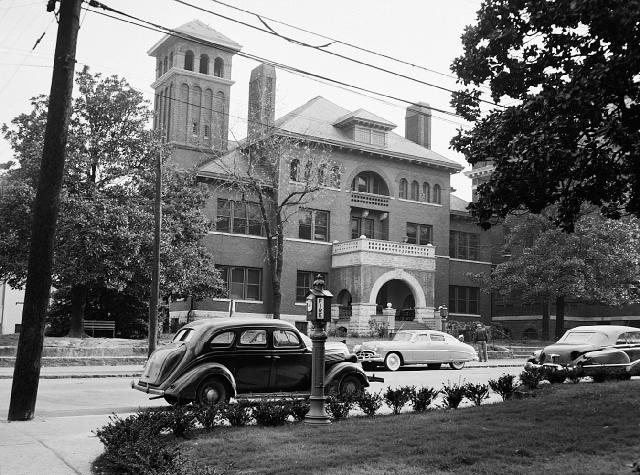
Courtesy of Special Collections & Archives, Georgia State University Library.
In 1982-83 an ambitious renovation project created a sixteen-story building that continues to be the core of the modern hospital, and in the early 1990s Grady embarked on a $298 million renovation involving nine architecture firms, including Atlanta-based Stanley, Love-Stanley.
Restructuring of Grady Memorial Hospital
Grady Memorial Hospital’s longstanding tradition of serving the poor and uninsured in the Atlanta area, many of whom are unable to pay for medical care, as well as reductions in state and federal funding, led to financial distress for the institution in 2007. In addition to a budget shortfall, much of Grady’s equipment and infrastructure were seriously outdated, and the hospital risked losing its accreditation, which would have led to further reductions in federal funding.
In January 2008 a coalition of state and community leaders agreed to create the Grady Memorial Hospital Corporation, a nonprofit corporation charged with administering the hospital, and in March members of a new seventeen-member board were announced. In response to the board’s fund-raising campaign to raise $100 million for the hospital, the Robert W. Woodruff Foundation pledged $200 million over four years, and the medical insurance company Kaiser Permanente pledged $5 million. The tumultuous year ended with Grady passing a surprise inspection and retaining its accreditation in November 2008.






